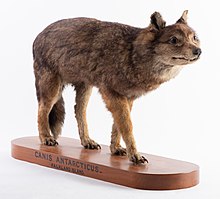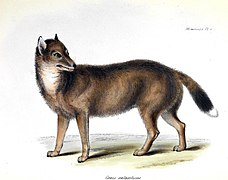Falkland Islands wolf
| Falkland Islands wolf[1] | |
|---|---|

| |
Otago Museum
| |
| Scientific classification | |
| Domain: | Eukaryota |
| Kingdom: | Animalia |
| Phylum: | Chordata |
| Class: | Mammalia |
| Order: | Carnivora |
| Family: | Canidae |
| Genus: | †Dusicyon |
| Species: | †D. australis
|
| Binomial name | |
| †Dusicyon australis (Kerr, 1792)
| |

| |
| Location of the Falkland Islands | |
The Falkland Islands wolf (Dusicyon australis), also known as the warrah ( in 1876, the first known canid to have become extinct in historical times.
Traditionally, it had been supposed that the most closely related genus was
The Falkland Islands wolf existed on both
History

The first recorded sighting was by Capt. John Strong in 1690.[10] Captain Strong took one on his ship, but during the voyage back to Europe it became frightened by the firing of the ship's cannon and jumped overboard.[10][11] Louis Antoine de Bougainville, who established the first settlement in the Falkland Islands termed it a loup-renard[12] ("wolf-fox"). The name "warrah" is an anglicised approximation of the term aguará (meaning "fox" in Guaraní, a Native American language), because of its similarity to the maned wolf (aguará guazú).

When
I landed in the creek and had hardly put a foot on shore, when one of the foxes of the country was chased by Pilot. I ran up as they were fighting and came to the poor dog's assistance who had nearly met his match, and a rifle ball soon settled the business, but the Pilot had received a terrible bite in the leg.
A live wolf was taken to London Zoo, England in 1868.[15] Another "Antarctic wolf" arrived in 1870. Neither animal survived long. Only a dozen or so museum specimens exist today.[4]
In 1880, after the animal had become extinct,
Darwin's description
Darwin writing about his 1834 visit to the Falklands in his Journal and Remarks (The Voyage of the Beagle) has the following to say of Canis antarcticus:
The only quadruped native to the island, is a large wolf-like fox, which is common to both
Indians, who have visited these islands, all maintain that no such animal is found in any part of South America. Molina, from a similarity in habits, thought this was the same with his "culpeu"; but I have seen both, and they are quite distinct. These wolves are well known, from Byron's account of their tameness and curiosity; which the sailors, who ran into the water to avoid them, mistook for fierceness. To this day their manners remain the same. They have been observed to enter a tent, and actually pull some meat from beneath the head of a sleeping seaman. The Gauchos, also, have frequently killed them in the evening, by holding out a piece of meat in one hand, and in the other a knife ready to stick them. As far as I am aware, there is no other instance in any part of the world, of so small a mass of broken land, distant from a continent, possessing so large a quadruped peculiar to itself. Their numbers have rapidly decreased; they are already banished from that half of the island which lies to the eastward of the neck of land between St Salvador Bay and Berkeley Sound. Within a very few years after these islands shall have become regularly settled, in all probability this fox will be classed with the dodo, as an animal which has perished from the face of the earth. Mr Lowe, an intelligent person who has long been acquainted with these islands, assured me, that all the foxes from the western island were smaller and of a redder colour than those from the eastern. In the four specimens which were brought to England in the Beagle there was some variation, but the difference with respect to the islands could not be perceived. At the same time the fact is far from improbable.[7]
-
H. Smith
-
The Illustrated London News (1873)
Biogeography and evolution
Darwin's comments
When organising his notes on the last stage of the Beagle expedition, Darwin wrote of his growing suspicions that the differences between the various Galápagos Islands mockingbirds and tortoises, as well as the possible dissimilarity of West Falkland and East Falkland Islands wolves, were but variants that differed depending on which island they came from:
When I see these Islands in sight of each other, & possessed of but a scanty stock of animals, tenanted by these birds but slightly differing in structure & filling the same place in Nature, I must suspect they are only varieties. The only fact of a similar kind of which I am aware is the constant asserted difference between the wolf-like Fox of East & West Falkland Islands. If there is the slightest foundation for these remarks the zoology of Archipelagoes will be well worth examining; for such facts [would] undermine the stability of Species.[16]
The word "would" was added after this passage was first written, suggesting a cautious qualification from his initial bold statement.[17] He later wrote that such facts "seemed to me to throw some light on the origin of species".[18]
Related species
A DNA analysis
Dusicyon avus, known from fossils from southern South America as recent as 400 years ago, was the closet known relative of the Falkland Islands wolf.[21]
In terms of skull shape and feeding habits, the animal was an opportunistic predator, more like a jackal.[22]
Biogeographical isolation on the Falklands
The route by which the Falkland Islands wolf was established in the islands was unknown for a long time, as the islands have never been connected to the mainland both inhabit islands much closer to a continent.
Berta and other authors suggest that it was unlikely that the wolf's ancestors could have survived the last Ice Age on the Falklands and they must therefore have arrived later, within the last ten thousand years, crossing a wide expanse of the South Atlantic.
The oldest known remains of Falklands Islands wolves date to approximately 3396–3752 years Before Present, found at Spring Point Farm in West Falkland, the only place in the Falkland Islands where subfossil bones of the wolf have been found. The scarcity of remains is likely due to the acidic peaty soil of most of the Falklands, which rapidly degrades bones.[26]
Genetics
DNA of the extinct mainland relative, D. avus, analyzed in 2013 suggests that its genetic history diverged from the Falkland Islands wolf only some 16,000 years ago, during the last glacial phase.
Ice Age land bridge
An Ice Age land bridge or ice connection between the Falkland Islands and South America, enabling the species' ancestors to traverse the gap, has long been suggested. There was never a true land bridge between the islands and South America, but submarine terraces have been found on the Argentine coastal shelf, formed by low sea-stands during the last glacial phase.[5] This suggests that there was a shallow strait as narrow as 20 km, which may have frozen completely at times.[5] It is possible that the founding population of the wolf crossed on this ice bridge during the last Ice Age.[19][5] The absence of other mainland mammals on the islands might be due to the difficulty of an ice crossing.[5]
In culture
Locations that are named after the wolf:
- Fox Bay, a bay and settlement on West Falkland
- Warrah River, West Falkland
See also
References
- OCLC 62265494.
- . Retrieved 12 November 2021.
- ^ Portela, Roberto. "Evolutionary ecomorphology of the Falkland Islands wolf Dusicyon australis" (PDF). Retrieved 31 October 2020.
- ^ a b c d "New Clues To Extinct Falklands Wolf Mystery". EurekAlert. Science Daily. 2009-11-03. Retrieved 2011-09-03.
- ^ PMID 23462995.
- hdl:11336/46106.
- ^ a b Darwin, Charles (1839). Narrative of the surveying voyages of His Majesty's Ships Adventure and Beagle between the years 1826 and 1836, describing their examination of the southern shores of South America, and the Beagle's circumnavigation of the globe. Journal and remarks. 1832–1836. (The Voyage of the Beagle). Vol. III. London: Henry Colburn. pp. 149–150.
- ISBN 978-0-8154-0433-0. Retrieved 4 September 2011.
- ^ Massam, Steve. "The Evans Warrah, The Identification". Falkland Islands Museum and National Trust. Archived from the original on 2011-10-04. Retrieved 2011-09-04.
- ^ a b "The First Sighting". Falkland Islands Museum and National Trust. Archived from the original on 2012-04-02. Retrieved 2011-09-08.
- ISBN 978-0-395-89228-2. Retrieved 4 September 2011.
- ^ Chisholm, Hugh, ed. (1911). . Encyclopædia Britannica. Vol. 10 (11th ed.). Cambridge University Press. p. 152.
- ^ "Dusicyon australis". International Union for Conservation of Nature. 4 September 2011. Retrieved 2011-09-04.
- ^ "Renshaw's Comment on Extinction". July 8, 2015. Archived from the original on 2015-07-08.
- ^ "A Falklands Wolf in London". Falkland Islands Museum and National Trust. Archived from the original on 2012-04-02. Retrieved 2011-09-08.
- ISBN 978-0-521-46569-4.
- ^ Eldredge, Niles (Spring 2006). "VQR – Confessions of a Darwinist". The Virginia Quarterly Review: 32–53. Retrieved 2008-04-15.
- ^ Darwin, Charles (1859). On the Origin of Species by Means of Natural Selection, or the Preservation of Favoured Races in the Struggle for Life (1st ed.). London: John Murray. pp. 1.
- ^ S2CID 36185744.
- ISSN 0024-4082.
- hdl:11336/46106.
- ^ Meloro, Carlo (10 January 2017). "Falklands 'wolf' that baffled Darwin was actually more like a jackal – new study". The Conversation. Retrieved 2017-01-30.
- ISSN 1514-5158. see figure 3
- ^ But even though the study has gone some way to clarifying the evolutionary origins of the Falklands wolf, the species still represents a great bio-geographical conundrum because the Falklands have never been connected to the South American mainland and no other land mammals – not even small rodents – have managed to live there. Connor, Steve (2009-11-03). "How scientists cracked puzzle of the Falklands wolf". The Independent. Mercopress. Retrieved 2011-09-01.
- ^ Berta, A. (1987). Origin, diversification, and zoogeography of the South American Canidae. Fieldiana: Zoology, 39, 455–471
- ^ PMID 34705512.
Sources
- Pernetty, Dom (1764). History of a Voyage to the Malouin Islands.
- de Bougainville, Louis Antoine. Voyage Round the World.
- Lydekker, R.; Johnston, H.; Ainsworth-Davis, J.R., eds. (1910). "Antarctic Wolf". Harmsworth Natural History. p. 441.




